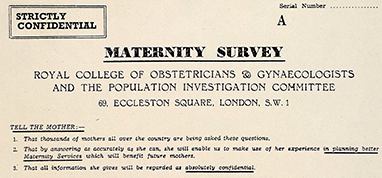History of the NSHD
During the 1930s and 1940s there were worries about the falling birth rate in the UK, and concerns that perhaps, in those years before the National Health Service (NHS), the cost of having children was so great that people were deterred from parenthood.
A survey was designed to look into the reasons behind the low birth rate by investigating the cost of childbirth and the availability, use and effectiveness of maternity services, and to provide information for use in the design of the NHS. That study took as its participants all the 16,695 births which occurred in England, Wales and Scotland during one week in March 1946.
Information on 13,687 babies was collected by health visitors when the babies were eight weeks old. Two different questionnaires were handed out; Questionnaire “A” asked about the use of maternity services, while Questionnaire “B” focused on the cost of pregnancy and childbirth. Survey results showed not only the high cost of having a baby, but that it was proportionally much more expensive for mothers in manual workers’ families than for those who were better off.
The study described a wide range of risks to the life and health of mothers and babies, and found these risks were much greater for poor families than for others. It also revealed that only one in five mothers had received pain relief during childbirth, and this information was used to change the law to permit midwives to give pain relief without a doctor present.

After the success of the Maternity Survey, a follow-up study was designed to examine the health and progress of around one third of the babies. This study was initially called the National Survey of Health and Development of Childhood, later renamed the Medical Research Council (MRC) National Survey of Health and Development (NSHD). Selection of the 5,362 babies studied was carried out at random, but in such a way as to ensure a good representation of babies from all over the country and from all parts of society. James Douglas was the studies first director.
These babies have been followed up 27 times through a combination of paper questionnaires and visits by health visitors or nurses in the home or in a clinic. Until 1965 a combination of the mothers, teachers, school nurses and doctors completed the questionnaires, while the study members completed tests of cognitive ability. Since 1965 the study members have completed their own questionnaires and nurses have conducted tests and examinations in participant’s homes or in clinics.
The MRC has funded the study since 1962.
